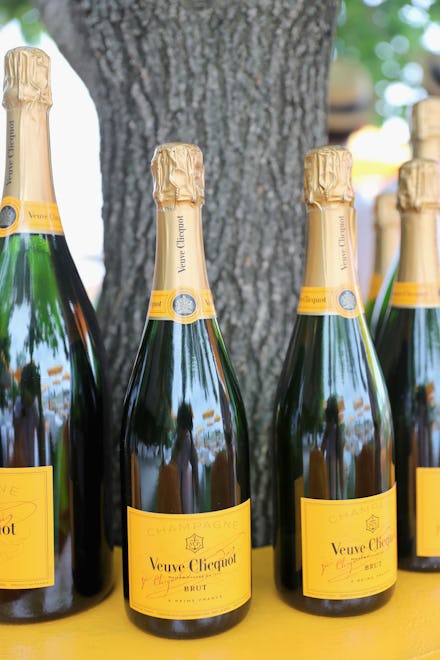You have an 18th-century woman to thank for the delight that is Veuve Clicquot

If you're ever lucky enough to stare at a bottle of Veuve Clicquot, you may notice a few details. One, the iconic label is always a certain hue of yellow, and printed on that bottle is an anchor with the initials "VCP" inside it. The name of this iconic Champagne, Veuve Clicquot, translates literally to "Widow Clicquot" from the French, and the top of every cork is encased with cage bearing a metal portrait of the widow herself, Barbe-Nicole Ponsardin, the hero of Champagne as we know it today.
"Because of her willingness to take risks without fanfare, the Widow Clicquot became one of the most famous women of her era," Tilar J. Mazzeo, author of The Widow Clicquot: The Story of a Champagne Empire and the Woman Who Ruled It wrote in her biography of the wine hero. "At the most critical juncture in the history of [Champagne], Barbe-Nicole dominated the industry,"
The humble beginnings of a Champagne legacy
It's 1805 and 27-year-old Barbe-Nicole just lost her husband, François, to an incurable illness, leaving her with his Champagne house and their young daughter. Having been a child of the French Revolution, Barbe-Nicole certainly had some strength and resiliency in her, and though at the time it was forbidden for women to own businesses, a widow inheriting their husband's business was totally legitimate.
Prior to François's tragic death, the couple had worked together at the Champagne house in Reims, France, which François managed with his father, Philippe, who was primarily a textile trader. With Europe at war, the potential for trade between countries was difficult, often thwarted by closed ports or Napoleon's troops.
To make matters even more difficult, Europe was experiencing its "little ice age," during which many rivers froze and temperatures dropped lower than normal. Anyone who has visited sunny California wine country to see the vines glimmer in the perfect coastal weather can guess why these low temperatures were detrimental to the Champagne business. Overall, it wasn't a great time to sell Champagne, let alone become rich from it, which actually may contribute to why women like Barbe-Nicole had the opportunity to have such a large stake in the Champagne houses: It had "dim prospects," as Mazzeo writes.
Luckily for Barbe-Nicole — who later went on to embrace mottos such as "There is only one quality — the best" — these "dim prospects" led her to become the women with the most self-made wealth in Europe of her era.
Wishing on a star may have changed the Champagne industry forever
Following many rough business years, 1811 brought a comet through Champagne — i.e., the symbol you'll see on bottles over 100 years later. Seeing a comet is cool no matter what, but for Barbe-Nicole, this sparkling fireball through the sky brought her luck. A great harvest and the ability to ship Champagne through the Russian blockade meant she could actually profit from the sparkling wine, thus creating the modern Champagne we love today.
The magic of marketing
The Widow Clicquot's Champagne was coveted by many, and knockoff versions even began to hit the market, sometimes unbeknownst to customers. Those investing in the luxury item, as well as Barbe-Nicole herself, needed brand identification. In an era when selling meant sending a salesman to a client, marketing wasn't really pertinent. The Widow, however, recognized the importance of brand identification and soon labeled the bottles — which, at the time, were made from hand-blown glass perfected to her standards — with a label very similar to the signature label Veuve Clicquot wears today.
Champagne gets its bubble by undergoing a second fermentation. That is, after the grapes are fermented to become wine, the wine is placed in a bottle and more yeast is added to ferment the wine again, which releases CO2 in the small space and creates bubbles. The process is much more labor-intensive than a wine undergoing a single fermentation, and filtering out the yeast sediment from bubbling Champagne was a difficult process. And without removing it, the Champagne would be muddy and unattractive. Barbe-Nicole wanted a clear sparkle!
As demand for her Champagne increased, Barbe-Nicole wanted her workers to remove the sediment faster, making as many bottles ready for shipment as possible. The workers claimed to be working as quickly as they could without spilling too many of the profits, so Barbe-Nicole took the work into her own hands. Cutting holes in her kitchen table along with her cellar master, she found a way to balance Champagne bottles upside down and at an angle, allowing the sediment to collect by the cork for easy removal. She would turn the bottles every few days to keep the sediment collecting at the bottom. The technique, now called riddling, is still used not only to make Veuve Clicquot, but countless other champagnes, as well.
As Mazzeo put it: "It is thanks to her technical innovation in the cellars that today we can find modestly priced bottles of Champagne on store shelves around the world. Had she not discovered [this] process, Champagne would have remained the drink only of the very rich or the very lucky."
And how lucky we are that she invented a way for us to enjoy Champagne on the reg? Cheers to Barbe-Nicole!